 |
|---|
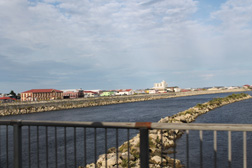 | We decided to spend the night in Greymouth, a picturesque town of about 10,000 people. It is located. logically enough, at the mouth of the Grey River, on a narrow coastal plain close to the foot of the Southern Alps. It has a history of coal and gold mining, although ecotourism and forestry are increasingly important. Fishing is a major industry, in spite of two notoriously dangerous sandbars in the river. The town is also the western terminus of the only railroad we encountered so far. The TransAlpine passenger train runs the 139 miles to Christchurch through 19 tunnels and four viaducts, the highest being 240 feet. Coal trains also operate on this line, carrying coal from the mines near here to Christchurch. |
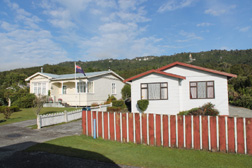 |
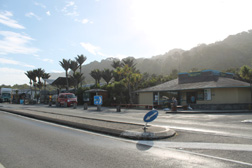 | One place that Pegah really, really wanted to see on our trip was the Pancake Rocks and Blowholes next to the town of Punakaiki, which sounds like "pancake." I expected an observation platform on the side of the highway, but Punakaiki has an attractive little tourist area that serves as the service center for the Paparoa National Park with taverns, cafes and restaurants. The park offers rainforest hikes, horseback riding, canoeing, swimming, surfing, fishing and kayacking. I wanted to have a photo taken of Pegah and me standing next to the entrance to the Pancake Rocks, but there wasn't anybody readily available, so we took pictures of each other and I blended them together in this composite.
|
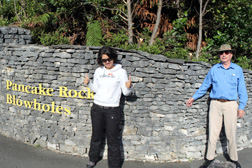 |
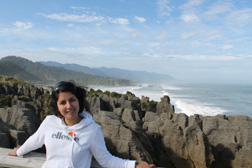 | The Pancake Rocks at Dolomite Point south of the main village are heavily eroded limestone formations. They are thought to have been created by the pressurized seabed cementing of alternate layers of calcium carbonate marine animal skeletons and soft plant material. The rock was then uplifted by the tectonic forces that formed South Island and subsequently weathered by wind and wave action into its present form. The attraction has a number of paved walkways with safety barriers and wheelchair accessible ramps. I took these photos of Pegah safe and secure inside the safety rails, but she made me a little nervous by climbing where I thought was too close to the edges of some of the walkways. |
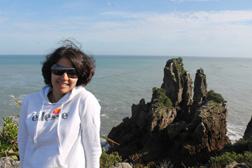 |
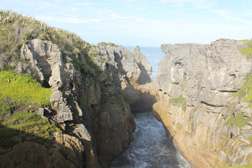 | The sea was fairly calm while we were there, so we didn't get to see the wave action on the blowholes for which the area is also known. Here vertical slabs of rock have been fractured by the wind, sea and tectonic forces. These have subsequently been broken up and washed away by the constant action of the waves, leaving vast vertical chasms that extend to the ocean. In harsh weather, especially during high tide, the waves crash against these formations, driving kilotons of seawater into the clefts. With no place to go but up, the water erupts violently out of the blowholes with tremendous force! This action further scours the blowholes in a constantly advancing process of erosion.
|
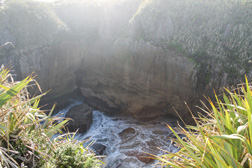 |
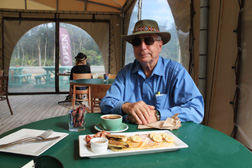 | I figured that no place called "Pancake Rocks" would be complete without a place to buy actual pancakes, so I was not at all surprised to find that pancake breakfast, with pancakes, sliced fried bananas and New Zealand style bacon, was served all day at the local cafe. Here we are in an enclosed outdoor dining area with some other patrons and some local birds. Most of the birds were flying about snatching up crumbs we threw to them or perching on electrical fixture wires directly overhead. I was careful to move my meal so it was not directly underneath any of them. One little fellow was cowering timidly under a chair. He only came out when I coaxed him out with pieces of pancake.
|
 |
 | This is obviously what he was cowering from. This gull appeared to fancy himself the king of the dining area. Pegah and I left him to help himself to the leftovers as we headed north to what I thought was the location of the "leaving the shire" scene in The Fellowship of the Ring. After convincing myself that I had entered the GPS coordinates wrong, because the location turned out to be in the ocean, we continued on to Westport Seal Beach. I didn't see any seals when we arrived, but the ticket lady at the entrance assured us that they were actually there but were somewhat difficult to see. She was so right! At first I didn't see anything but rocks, but then Pegah spotted some frolicking in the surf.
|
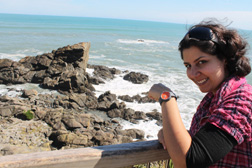 |
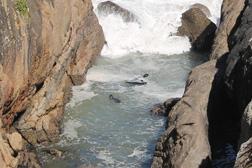 | Sure enough, there were seals all over the place; big seals, little seals, baby seals, momma seals, and probably some daddy seals, too! The swells were crashing against the coastal outcrops, sending huge waves into the clefts among them, but the seals just went with the flow and seemed to enjoy the challenge of not getting dashed against the sheer cliff faces. Further inland, this baby seal was exploring the moss-covered bolders. The color of the seals' coats makes them relatively easy to spot against the gray background when wet, but when the rock are also wet, the seals all but disappear. The easiest way to spot them is just to watch the rocks until something moves. Then they materalize as if by magic!
|
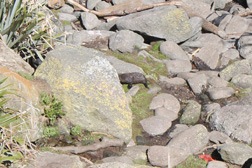 |
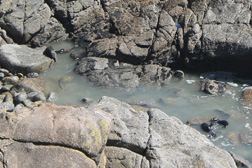 | What looked like smaller, younger seals were relaxing in a backwater pool where they almost vanished among the partially surmerged rocks in the shallow water. They seemed to be congregating around a larger one sitting on a rock, possibly a nursing mom. The animals obviously knew we were there, and several of them spent minutes at a time watching us until they lost interest and resumed their exploration of the rocky cove. One large seal, however, stayed pretty much in one spot with a commanding view of the others, regarding us with what appeared to be keen interest. Having dried off, he had morphed to a lighter color that made him much harder to see among the dry gray rocks.
|
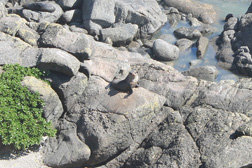 |
| Click here to go to the next page. |
|---|

































